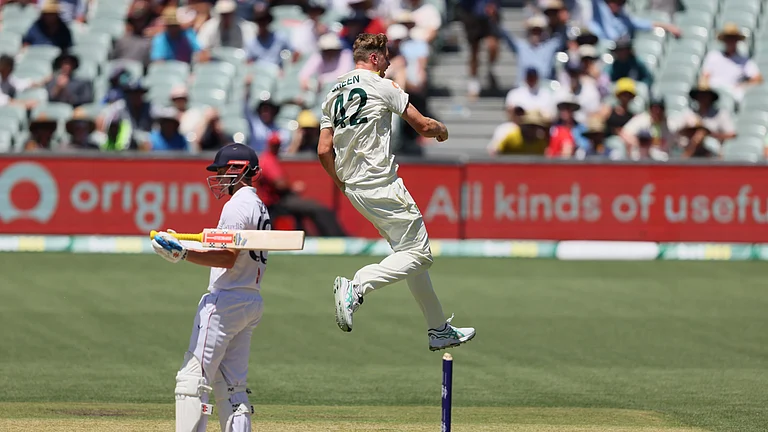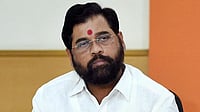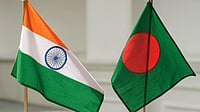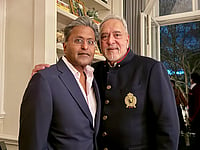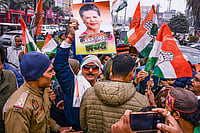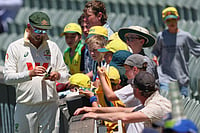It was in September 1996 that the world first caught a glimpse of the Talibanslust for blood and vengeance. Kabul had fallen and the Taliban had vanquished the(anti-Soviet) mujahideen. Marauding bands of gun-totting youth took over the presidentialpalace and beat the former communist President Najibullah, then under house arrest,senseless. They then castrated him and tied his bleeding body to the jeep before drivingthe vehicle several times around the palace compound. Najib was then shot dead. They metedthe same treatment to his brother. But their rancour still didnt subside. They hungthe two bodies from a concrete traffic control post outside the palace, located near theUN headquarters there.
The following day, a stunned world saw pictures of the two bodies hanging with steelwire nooses, unlit cigarettes dangling from their lips. The message was clear: a virulentstrain of Islam was about to sweep through Afghanistan.
Six years later, the Talibans self-claimed heavy artillery barrage on the BamiyanBuddhas is yet another manifestation of their medieval outlook. Even 11 days after theorder to destroy the statues was issued, there is still confusion about the extent of thedamage. The Taliban are the only source, and they claim that 75 per cent of the twostatues had been destroyed before Id. The rest of the task, say the Taliban, will becompleted soon.
The world is hoping that it is still possible to prevent complete destruction of thestatues. Hectic diplomatic activity was already under way last Thursday. A Japaneseparliamentary team was trying in Islamabad to get to Kabul and UNs special envoyFrancis Vendrell was hoping to meet the Taliban leadership. unesco official Pierre laFrance met Afghan foreign minister Wakil Ahmad Muttawakil in Kandahar but failed to getany assurance about Bamiyan.
The Talibans advent to power began when it replaced the mujahideen who had beenpropped up by Pakistans Inter Services Intelligence (isi), the Saudis and theAmericans to fight the Soviet-backed Kabul regime of Najibullah. In fact, in March 1987,after the mujahideen, led by Gulbuddin Hekmatyar, launched their attack on Tajikistan, thethen cia director, William Casey, made a secret trip to Pakistan to review the operation.
Nine years later, however, the mujahideen warlords were a corrupt, squabbling lot. Itwas into this ideological vacuum that Mullah Omar made his entry, and his band offollowers started an Islamic reform movement. This came to be known as theTaliban, or students (of Islam) who formed the core group of Mullah Omar. Drawn largelyfrom Afghan refugees who had fled their country following the Soviet invasion andPakistani impoverished classes, they were young men who had studied in madrassas dottingthe Pakistan-Afghan border. These seminaries taught an obscurantist version of Islam drawnfrom the orthodox Wahabi school. For them, jehad was an instrument of political and socialchange.
In 1996, Mullah Omar was anointed by his fellow Taliban travellers as Amir-ul-Momineen(leader of the faithful). He had started off as a latter-day Robin Hood, till NasirullahBaabar, Benazir Bhuttos interior minister, began to back him with money andfirepower. Once Islamabad weighed in, the rest followed, as is usual in Afghanistan. Thearrangement was simple: Pakistan backed the Taliban and the Taliban took over Afghanistan,beginning with Kandahar in 1994. Thousands of mesmerised students from the madrassasflocked to the new messiah.
After taking over Kabul in 1996, the Taliban imposed their version of Sharia oneverything from nail polish to sodomy. But the process was till then not devoid ofdebates. For instance, unsure of how to punish sodomy, the Taliban initially wanted tothrow the offenders off a high roof. But then a new solution was offered. The punishmentwas first recorded in February 1998: three men accused of sodomy were first partiallyburied in the ground, adjacent to a large mud and brick wall. Then a Taliban tank toppledthe wall, burying the men alive. It was innovative, effective, and most importantly,spectator-friendly. Later Anis, the Taliban newspaper, wrote that Mullah Omarattended the function to give Sharia punishment to the three buggerers...
It was Omar who ordered the destruction of the Bamiyan Buddhas. His word is law inAfghanistan. As Wakil Ahmed (one-time food-taster, driver, personal attendant andspokesman of Mullah Omar) told an Arabic magazine Al-Majallah in 1996: Decisions arebased on the advice of the Amir-ul-Momineen. For us consultation is not necessary. Webelieve that this is in line with the Sharia. We abide by the Amirs view. Even if healone takes this view...
Little is known about Mullah Omar. He is a Pashtun born circa 1959 at Nodeh villagenear Kandahar. After his father died, he moved to Singesar village in Mewand district ofKandahar and started a small madrassa. He fought against Najibullah between 1989 and 1992,and was wounded four times. Omar has three wives, the second one a teenager whom hemarried in 1995. His five children study in the madrassa he started and his family livesin Singesar. He is well-built and wears a black turban and beard. These details are fuzzybecause he has reportedly never been photographed.
Omar reportedly keeps near him two huge tin trunks, one which contains afghani, thelocal currency, the other American dollars. Together the trunks form the treasury of theTaliban movement. Journalist Ahmed Rashid notes in his insightful book (Taliban:Militant Islam, Oil and Fundamentalism in Central Asia) that this renders the task ofmaking a national budget next to impossibleeven if the expertise is available,which in any case is absent.
What then keeps the Taliban afloat financially, apart from opium money? Rashid providessome figures: In 1997-98 Pakistan provided the Taliban with an estimated US$30million in aid. This included 600,000 tonnes of wheat, diesel, petroleum and kerosene fuelwhich was partly paid for by Saudi Arabia, arms and ammunition, aerial bombs, maintenanceand spare parts for its Soviet-era military equipment such as tanks and heavy artillery,repairs and maintenance of Talibans air force and airport, road-building,electricity supply in Kandahar and salaries. Officially, Pakistan denied it was supportingthe Taliban. The US, on the other hand, winked at the Taliban all through theirKandahar-Kabul sojourn, till various womens groups made it impossible for theClinton administration to politically flirt with and then embrace Mullah Omar.
The Taliban leadership is a disabled lot. Omar himself is blind in the right eye. Helost it in 1989 when a Russian rocket exploded close to him. Again, the governor ofKandahar, Mullah Mohammed Hassan, a founder member of the Taliban, has a peg leg and thetip of one of his fingers is missing, lost to a shrapnel wound. Justice minister NuruddinTurabi and former foreign minister Mohammed Ghaus are both reportedly one-eyed wonders aswell. Kabul mayor Abdul Majid doesnt have one leg and two fingers. And they seem tolead by example. According to 1998 figures, the number of families headed by a disabledperson was 63,000. Under the Taliban the only productive industry relates to factoriesmaking artificial limbs, crutches and allied products.
BUT such disabilities have only hardened the Taliban leaders. In a system of instantcorrective measures, the Talibans cures are often drastic. One woman had the top ofher thumb amputated. Her crime? She wore nail polish. As recently as February 26 thisyear, 22 barbers were arrested in Kabul for surreptitiously giving men Leonardo DiCapriohairstyles. In 1998, there was an instance when three Afghan boxers were banned from acompetition in Karachi, because they would not shave off their beards to meet the boxingrules. They feared that if they returned home clean-shaven the Taliban morality policewould chop off their heads.
Inexplicable are the ways of the Taliban. Spectators are not allowed to clap or cheerat sporting events in Afghanistan, not that there are many, anyway. They can only chantAllahu Akbar. And should a game coincide with prayer time, the players must break forprayers. An edict further enjoins: Both the spectators and players should offerprayers in congregation.
There is scarcely anything that is not proscribed under the Taliban. TV is banned, as issmoking, movies, wedding parties, any sort of mixed-sex gathering, cameras, photographs,childrens toys, kites, dolls, employment for women, any kind of make-up, jewellery,plucking of eyebrows, white socks (for some strange reason the Taliban have decreed whitesocks to be sexually arousing), high-heeled shoes and laughing loudly. There can be nopictures or portraits hung at home. When the Associated Press reported in 1996 that musicis banned, it quoted education minister Mullah Abdul Hanifi saying it was because it(music) creates a strain in the mind and hampers the study of Islam. Education forgirls is also banned. Tailors are banned from measuring women for clothes. Women cannot gooutside without a burqa and even then must be accompanied by a male relative. Commentatorshave wryly noted that it is probably simpler to enumerate the things Taliban have notbanned than to make an exhaustive list of banned substances, which, for some reason,includes paper bags, too.
To put it simply, under the Taliban, culture is banned. Celebration of the Afghanspring festival, Navroz, is proscribed. It used to mark the first day of the Persian solarcalendar (pre-Islamic and Zoroastrian in origin), when the people visited their relativesgraves. The Taliban has presided over a phenomenal number of deaths. In 1998, for example,the Red Cross reported that the number of Afghan families headed by a widow had reached98,000. According to available figures, the infant mortality rate is 163 deaths perthousand births, the highest in the world. A quarter of all children do not reach theirfifth birthday. The number in other developing countries is one-tenth of this. Nobody hasyet come up with conclusive figures of the mounting dead.
And yes, women cannot work, except in some health-related sectors. This has been tough.Before the ban came in 1996, 70 per cent of the teachers in Kabul were women, so were 50per cent of civil servants and university students, and 40 per cent of all doctors. Now,there are no educated or professional classes in that country.
The Taliban now mans everything. There is an irony here. The word Talib means student;taliban is its plural. Although schooling is not banned, at least for the boys, theschools are all shut. By December 1998 the unicef reported that the countryseducational system had collapsed. In its assessment, nine in every 10 girls and two out ofevery three boys had not enrolled in school.
This is partly because of the Taliban leaders, most of whom hail from poor provinceswhich had no schools. This is true of Mullah Omar too. With no teaching going on, thesestudent-followers of Mullah Omar are running amok amputating, beheading, stoning to death,whipping, enforcing the Sharia as they see it. Most Muslim countries are mute witnessesbut they arent tacit supporters either. The Organisation of Islamic Conference(oic), for instance, has not recognised the Taliban regime.
After the Taliban took over Kabul in 1996, its Olympic-size stadium reports full houseregularly. But it is not for witnessing sporting events. The assembled spectators at theKabul stadium witness amputations, stoning to death of women found guilty of adultery,summary executions and the like, not games. The Taliban expect the Afghans to watch andlearn a lesson or two about the kind of Islam Mullah Omar wants practised. But spectatorscannot applaud. In case there is applause, the Taliban have the discretion to chop theoffending hands off.
In 1996, all males were given six weeks in which to grow a full beardor face theconsequences. This was tough for some ethnic groupsespecially the Hazaraswhoare only minimally hirsute. But this is not the reason why the Hazaras are dying at thehands of the Taliban, sometimes hundreds at one go. The Taliban has been accused by the UNSpecial Rapporteur for Human Rights in Afghanistan of massacring several thousand Hazarasand other minorities while taking over Mazar-e-Sharif and Bamiyan because the Taliban,besides religion, also discriminates along ethnic and linguistic lines. In November 1998,the minuscule Sikh and Hindu minorities were asked to wear an identification band.
The Taliban sank into the Indian consciousness when IC-814 was hijacked to Kandahar,the Taliban headquarters, in December 1999. Some militants fighting in Kashmir get trainedin Afghanistan. Should India have a forward policy on Afghanistan? Opinion seems dividedin government circles. One senior security official told Outlook: What we have nowis a drip irrigation-type policy, we keep feeding Masood drop by drop. It is hardly apolicy. Others too, argue that in security terms it would be wrong to viewAfghanistan and Pakistan separately. A few others argue that sections of the Taliban arenot fundamentally well-disposed towards Pakistan, and India should cultivate thosesections. But for most part, Indian policy on Afghanistan seems limited to co-sponsoringresolutions in the UN, painting New Delhi as a victim of terrorism. And catching up on thedevelopments in Afghanistan through the media.









